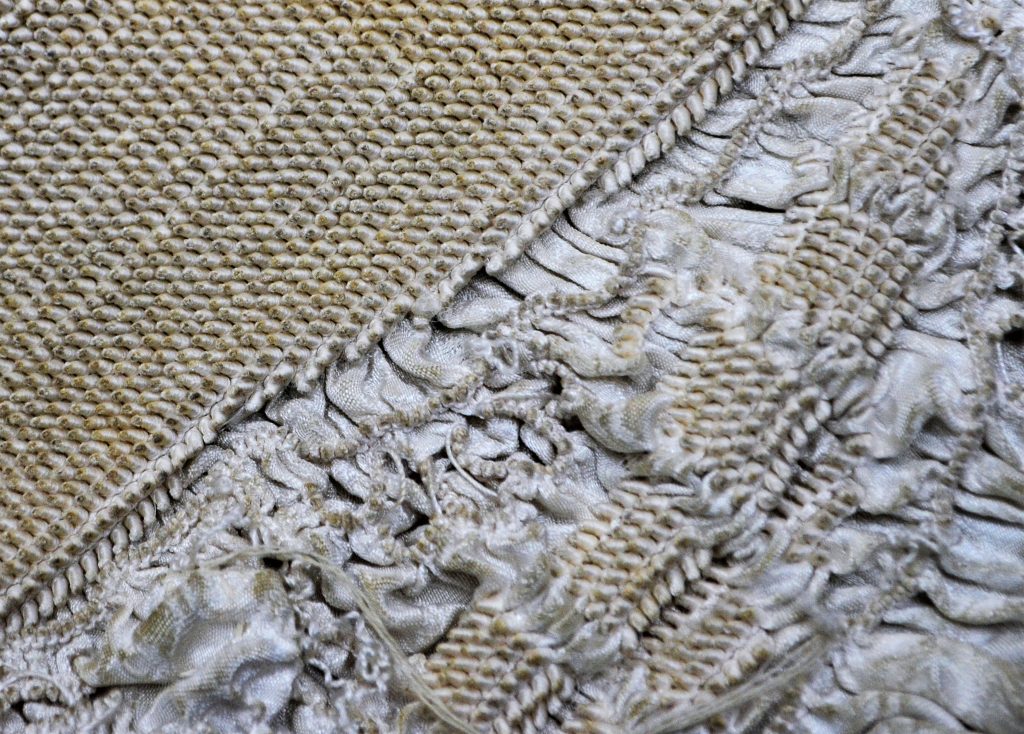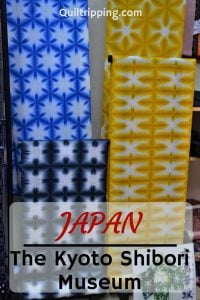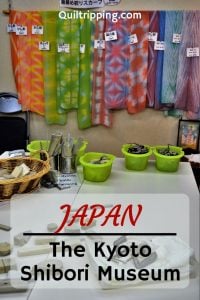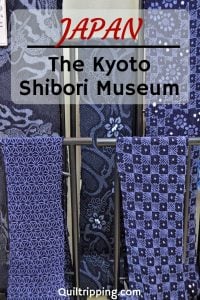Last Updated on 10/23/20 by Rose Palmer
The Kyoto Shibori Museum preserves and promotes a disappearing tradition for producing decorative Japanese textiles. On a visit not too long ago, I learned that the Japanese art of shibori fabric dying is to tie dying like Leonardo da Vince’s Mona Lisa is to a paint by number canvas – it’s a whole different world of artistry. I took one of the museum’s shibori dying classes where I learned all about this ancient Japanese technique and also went home with a beautiful handmade souvenir.
When traveling, I am always on the lookout for interesting classes that tap into my creative side and that will give me a small glimpse into the local culture. I came across a unique class on traditional Japanese shibori tie dying as I was looking for things to do in Kyoto during a winter visit. The class was offered at the Kyoto Shibori Museum, which by itself looked like it would also be an interesting and less touristy experience.
As a good mom and cub scout and girl scout leader, over the years I did my share of tie dying t-shirts with my kids. But, as I learned on my visit to the Kyoto Shibori Museum, the techniques we used and the final products that we produced were a weak imitation of the intricate tie dying that is the core of Japanese shibori.
What is Shibori?
Shibori is an ancient Japanese art form where a piece of fabric is folded, twisted, or bunched and then tightly sewn or bound with thread. The threading is done in such a dense fashion that it acts as a resist when the fabric is dyed, producing a pattern of dyed and undyed material once all the thread is removed. In Japan, these techniques have been practiced and improved upon for over 1300 years.
In one of the most labor intensive and intricate forms of shibori, extremely small sections of fabric (usually silk) are pinched between the fingers of one hand and then tightly wound with thread with the other hand. The trick is to wind the thread so tightly that no dye can penetrate, and then leave a tiny bead of fabric exposed at the tip which will take on the dye.
This little bud of tied fabric is called a “shirome”. This process forms a tiny dot of color, surrounded by a white circle without color. Tens of thousands of dots on a piece of fabric form a design, similar to a pixilated image. The skill is in producing uniform and closely packed buds in the required pattern established by the designer. A strip of fabric that is one foot wide by 30 ft. long would take an artisan a year to completely bind using this method.

Below is an example of a small piece of fabric (white) that has been tied in the shibori technique (the white fabric). Above it, the burgundy fabric shows the pattern that is produced once the shibori fabric has been dyed and all the threads removed. Over the centuries, the Japanese artisans have developed different ways of tying the fabric to produce different looks to the finished product. These techniques have been passed down from one generation to the next, so that in the Kyoto area alone there are over 50 different techniques for producing a shibori pattern.

The Kyoto Shibori Museum
I learned all about shibori and saw some exquisite examples at the Kyoto Shibori Museum. This is the only museum in Japan that specializes in the art of shibori. The mission of the Kyoto Shibori Museum is to preserve and promote the art of Kyo-Kanoko-Shibori, the shibori technique which is specific to the Kyoto area. The skills for this delicate and time consuming practice are slowly disappearing. Through their classes and exhibits, the museum works to educate and provide continuing value for this very unique Japanese traditional art form.
The Kyoto Shibori Museum had beautiful items on display that were produced using this tightly bound shibori method. From a distance, the kimono in the photo below looks like it has a grey background, but a closer inspection shows that the fabric is covered in tiny shibori produced dots.

Another kimono on display at the museum showed a beautiful Japanese pastoral scene with Mt. Fuji in the background. This design was also made with lots of little colored dots resulting from the tied and dyed shibori process. Even the undyed portion of the kimono fabric was tied so that it had the same puckered texture as the colored section. Again, a close up provides an appreciation for the detail and intricacy of this work.
About once a quarter, the museum also cycles through new exhibits featuring different aspects of shibori. In the museum shop, you will also find a variety of items in all price ranges made with different shibori techniques. I picked up a few pieces of shibori died blue and white fabric that will eventually make its way into a quilt.
The shibori class
Kyoto’s Shibori Museum is not on the standard tourist route in Kyoto. It’s not hard to get to, but you do have to make an effort to get there. I was fortunate to discover it when I was searching on line for unique and interesting experiences in the city. The museum offers a number of classes in shibori dying where you learn hands on some of the easier techniques and get to go home with your own hand made souvenir.
I participated in this experience on a January visit to Kyoto, and this was an excellent wintertime activity. As it turned out, I was the only visitor present that day, so I had the benefit of basically getting an unhurried private class as well as a detailed tour of the museum. The instructor spoke perfect English, though on that day, I think he was the only one there that did so.
With the instructor acting as a translator, I had a lively conversation with the staff. The folks there were as interested in me and where I was from and why I was there as I was in them and their facility. Apparently, they were not used to getting individual foreign travelers – the foreigners usually visit as part of a tour group on their way to the Tokyo International Quilt Festival.
The class I chose presents a simpler shibori technique, Itajime Shibori, which can be practiced by a typical person, yet still produces beautiful results. The process starts with a pure white silk scarf which is folded in a very specific order so that a completely symmetrical pattern is formed.
When the folding is complete, you end up with a small triangular wedge of fabric. The next step is to attach a wooden shape to each side of this silk triangle and clamp the whole thing together very tightly. The wood shapes act as the resist for the dying process.

The next step was to pick a color and submerge the fabric in the dye. If you are dying with more than one color, you start with the lightest color first. Then you repeat the process by clamping the fabric in between a second pair of wooden shapes, and submerging in a second pot of dye. Finally, the wood blocks and clamps are removed, the fabric is rinsed and dried, and then you get a surprise reveal of the pattern created on the silk scarf.
Apparently, the director of the museum always gets the privilege of helping with the final reveal.


The Kyoto Shibori Museum is located southeast of Nijo castle. It is a 5 minute walk from Nijo castle or Nijojo-mae Station on Subway Tozai line. It is a 10 minute walk from Karasuma-Oike Station on Subway Karasuma line, Exit 4-1.
For up to date information on visiting the Kyoto Shibori Museum, please visit https://www.kyotoshibori.com/ . On the Access page you will find a Google map which will also help you find the location.
For ideas on other unique museums in Kyoto , https://www.kyoto-museums.jp/en/ is a good resource.
I also saw exceptional examples of shibori and artistic kimonos at the Itchiku Kubota Art Museum in Kwaguchiko, which is near Mt. Fuji and not too far from Tokyo. Itchiku Kubota was a textile artist that had devoted his life to recreating one of the lost textile dying techniques from the 16th century.
Thanks for visiting.
Rose
Pin This!










